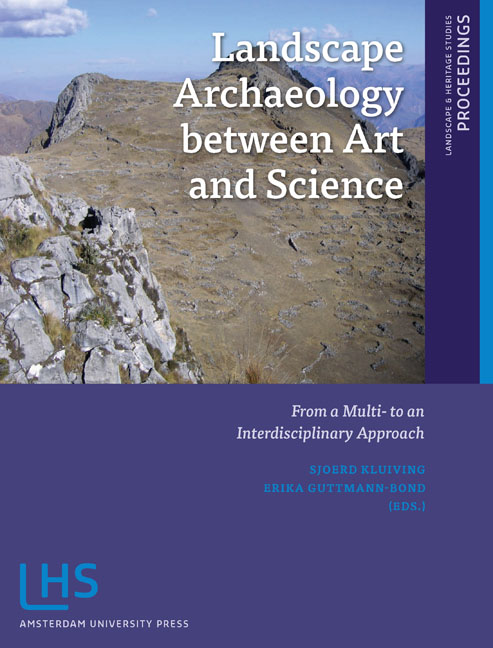Book contents
- Frontmatter
- Contents
- Preface
- Introduction: LAC2010: First International Landscape Archaeology Conference
- THEME 1 HOW DID LANDSCAPE CHANGE?
- THEME II IMPROVING TEMPORAL, CHRONOLOGICAL AND TRANSFORMATIONAL FRAMEWORKS
- THEME III LINKING LANDSCAPES OF LOWLANDS TO MOUNTAINOUS AREAS
- THEME IV APPLYING CONCEPTS OF SCALE
- THEME V NEW DIRECTIONS IN DIGITAL PROSPECTION AND MODELLING TECHNIQUES
- THEME VI HOW WILL LANDSCAPE ARCHAEOLOGY DEVELOP IN THE FUTURE?
- Miscellaneous Endmatter
1.10 - From Feature Fetish to a Landscape Perspective: A change of Perception in the Research of Pingo Scars in the late Pleistocene Landscape in the Northern Netherlands
Published online by Cambridge University Press: 21 January 2021
- Frontmatter
- Contents
- Preface
- Introduction: LAC2010: First International Landscape Archaeology Conference
- THEME 1 HOW DID LANDSCAPE CHANGE?
- THEME II IMPROVING TEMPORAL, CHRONOLOGICAL AND TRANSFORMATIONAL FRAMEWORKS
- THEME III LINKING LANDSCAPES OF LOWLANDS TO MOUNTAINOUS AREAS
- THEME IV APPLYING CONCEPTS OF SCALE
- THEME V NEW DIRECTIONS IN DIGITAL PROSPECTION AND MODELLING TECHNIQUES
- THEME VI HOW WILL LANDSCAPE ARCHAEOLOGY DEVELOP IN THE FUTURE?
- Miscellaneous Endmatter
Summary
ABSTRACT
In the northern part of the Netherlands a number of frost mound remnants are known. Some of these have been interpreted as pingo scars which have historically been regarded as good habitation locations for hunter-gatherers because of their relatively high position in the landscape and their easy access to water. The existence of a direct association between the higher ridges, known as ramparts, of the pingo scars and finds from early prehistory has been a common idea in archaeology in the northern provinces of the Netherlands. Indisputably, pingo scars provide an excellent base for environmental reconstruction as they have been filled with organic sediments from the early Holocene onwards and have proven to be an effective pollen trap, making them indispensable for local palynological research.
In a recent study the connection between archaeological remains, pingo scars and the corresponding landscape was investigated, resulting in an unexpected outcome. The historically assumed association between the pingo scars as isolated features and human occupation thereof seems to be nonexistent when researched on a metadata scale. It was concluded that other parameters lie at the basis of this assumption. The human occupation and its interaction with the landscape seem to be based on much larger environmental elements than these specific features themselves.
KEYWORDS
pingo scars, Pleistocene, Stone Age, landscape archaeology, Netherlands
INTRODUCTION TO PINGO SCARS: DEFINITIONS AND DATES
Frost mounds in general and pingos in particular, are ice-pushed mounds growing in periglacial conditions, such as those at the end of the Weichselian in Europe. When the soil cover of a pingo is pushed upwards due to the growth of the ice lens underneath it, the top of the mound will tear at a certain height and the material will start to slide down (gelifluction), which leads to the formation of a rampart. The height at which this happens depends on the thickness of the soil cover or overburden. After a while, the top of the ice core will be exposed and can subsequently melt from the radiation of the sun. Eventually, this leads to the melting of the greater part (or the whole) of the ice lens. The mound collapses and a lake surrounded by rampart, also known as pingo scar, is formed (amongst others, Mackay 1972; Watson 1972; Mackay 1979; De Gans 1988).
- Type
- Chapter
- Information
- Landscape Archaeology between Art and ScienceFrom a Multi- to an Interdisciplinary Approach, pp. 151 - 164Publisher: Amsterdam University PressPrint publication year: 2012



